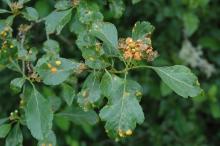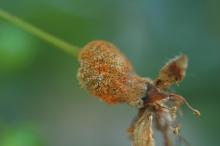See:
Juniper (Juniperus spp.) - Rust
Cause Three fungi are reported to cause rust on crabapple in the Pacific Northwest. Gymnosporangium libocedri has been reported from Oregon with incense-cedar (Calocedrus decurrens) as the alternate host. Both G. nelsonii (alternate host, juniper) and G. nootkatense (alternate host, Alaska yellow-cedar, Chamaecyparis nootkatensis) have been reported from Washington. The cedar-apple rust (G. juniperi-virginianae) common in the Eastern States has not been reported from the Pacific Northwest. Other, rosaceous hosts may be infected besides crabapple, including pear, hawthorn, mountain ash, and serviceberry.
Spores (teliospores) produced on incense-cedar or juniper infect crabapples from April to June. Aeciospores produced on the crabapples can infect the alternate host from June to August during favorable weather. Telia are not produced until the following year but can continue production for the next 3 years.
Spores (teliospores) produced on Alaska yellow-cedar infect crabapples from mid-May to June. Aeciospores produced on the crabapples can infect the alternate host from June to late September during favorable weather. Uredinia may be produced the following year to reinfect other Alaska yellow-cedar from June to October. Telia are not produced until the second year after initial infection.
Symptoms Yellow-orange to red cup-shape pustules (aecia) form on fruit and also can be found on shoots and leaves. Fruit are malformed, becoming indented where the pustules form. Some fruit may mummify as it matures. Pustules can girdle green shoots, causing a shoot dieback.
Cultural control
- Remove or do not grow alternate hosts next to crabapple plantings. Separating hosts by 0.5 to 2 miles has been recommended.
- Remove galls from juniper alternate hosts.
Chemical control Apply during the time cedar trees have swollen, orange telia in the spring (April to June). Do not apply if fruit is to be consumed.
- Aprovia at 5.5 to 7 fl oz/A plus an adjuvant. Do not use within 30 days of harvest. Group 7 fungicide. 12-hr reentry.
- Armada 50 WDG at 3 to 9 oz/100 gal water. Do not use a silicone-based surfactant. Not for nursery or greenhouse use. Group 3 + 11 fungicide. 12-hr reentry. For nonbearing fruit trees only.
- BioAdvanced Disease Control at 0.75 fl oz/gal water. H
- Bonide Fung-onil Multi-purpose Fungicide at 2.25 teaspoons/gal water. Group M5 fungicide. H
- Broadform at 4 to 8 fl oz/100 gal water. For nonbearing fruit trees only. Group 7 + 11 fungicide. 12-hr reentry.
- Concert at 9 to 17 fl oz/100 gal water. May cause injury to buds, blooms or tender new growth. Landscape use only. Group 3 + M5 fungicide. 12-hr reentry.
- Daconil Weather Stik at 1.38 pints/100 gal water every 7 to 14 days. Treated fruit must not be eaten. Group M5 fungicide. 12-hr reentry.
- Eagle 20 EW at 6 to 12 fl oz/100 gal water. Do not use treated fruit for food. Group 3 fungicide. 24-hr reentry.
- Flint Extra at 2.5 to 2.9 fl oz/A for edible types or Compass 50 WDG at 2 to 4 oz/100 gal water for ornamentals. Group 11 fungicide. 12-hr reentry.
- Fontelis at 16 to 20 fl oz/A. Do not use within 28 days of harvest. Group 7 fungicide. 12-hr reentry.
- Inspire Super at 12 fl oz/A. Do not apply within 14 days of harvest. Group 3 + 9 fungicide. 12-hr reentry.
- Mancozeb-based products. Group M3 fungicides. 24-hr reentry.
- Fore 80 WP at 1.5 lb/100 gal water plus a spreader-sticker.
- Protect DF at 1 to 2 lb/100 gal water plus 2 to 4 oz spreader-sticker. Do not use treated fruit for food.
- Miravis at 3.4 fl oz/A. Do not use within 30 days of harvest. Group 7 fungicide. 12-hr reentry.
- Monsoon Turf at 4 to 10 fl oz/100 gal water. Group 3 fungicide. 12-hr reentry.
- Myclobutanil 20 EW T&O at 6 to 12 fl oz/100 gal water plus spreading agent. May observe a PGR effect. Group 3 fungicide. 24-hr reentry.
- Myclotect at 4 to 6 fl oz/100 gal water plus spreading agent. May observe a PGR effect. Group 3 fungicide. 24-hr reentry.
- Propiconazole-based products. Group 3 fungicides.
- Alamo is registered for trunk injection, see label for details. Group 3 fungicide.
- Banner MAXX at 2 to 4 fl oz/100 gal water. For nonbearing fruit trees only. 12-hr reentry.
- Infuse Systemic Disease Control at 0.5 Tbsp/gal water. H
- ProCon-Z at 2 to 4 oz/100 gal water. 24-hr reentry.
- Propizol is registered for trunk injection, see label for details. 24-hr reentry.
- Strider at 2 to 4 fl oz/100 gal water. Also registered for trunk injection, see label for details. Group 3 fungicide. 12-hr reentry.
- Systemic Fungicide (ferti-lome) at 0.25 fl oz/gal water. H
- ProStar 70 WG at 3 to 6 oz/100 gal water. Group 7 fungicide. 12-hr reentry.
- Rhyme at 4 to 6 fl oz/A. Do not use within 14 days of harvest. Group 3 fungicide. 12-hr reentry.
- Spectracide Immunox Multi-Purpose Fungicide Spray Concentrate for Gardens at 1 fl oz/gal water. Group 3 fungicide. H
- Spectro 90 WDG at 1 to 2 lb/100 gal water. Group 1 + M5 fungicide. 12-hr reentry.
- Tebuconazole-based fungicides are registered. Do not use within 75 days of harvest. Group 3 fungicides.
- Tebucon 45 DF at 4 to 8 oz/A. 5-day reentry.
- Tebuzol 3.6F at 4 to 10 fl oz/100 gal water. Not for food. No reentry interval listed.
- Torque at 4 to 10 fl oz/100 gal water. 12-hr reentry.
- Terraguard SC at 2 to 8 fl oz/100 gal water. Group 3 fungicide. 12-hr reentry.
- Topguard SC at 8 to 12 fl oz/A. Do use within 14 days of harvest. Group 3 fungicide. 12-hr reentry.
- Tourney EZ at 1 to 4 oz/100 gal water. Group 3 fungicide. 12-hr reentry.
- Trionic 4 SC at 8 to 16 fl oz/A. Do not apply within 14 days of harvest. Group 3 fungicide. 12-hr reentry.
Note Some registered products offer only suppression of this disease and thus are not recommended for use. These products include Avelyo, Merivon, Pristine and Tesaris.
Reference Ziller, W.G. 1974. The Tree Rusts of Western Canada. Canadian Forestry Service Publication 1329.



